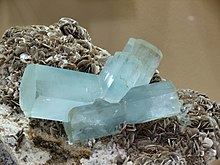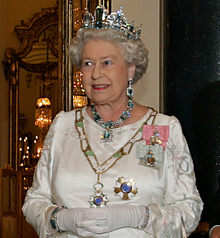Aquamarine (gem)
| Aquamarine | |
|---|---|
 Aquamarine on Muscovite | |
| General | |
| Category | Beryl variety |
| Formula (repeating unit) | Be3Al2Si6O18 |
| Identification | |
| Fracture | Conchoidal |
| Mohs scale hardness | 7.5 to 8 |
| Streak | White[1] |
| Specific gravity | 2.65-2.85 |
Aquamarine is a pale-blue to light-green variety of beryl.[2] The color of aquamarine can be changed by heat.[3]
The aquamarine has a chemical composition of Be3Al2Si6O18,[4] also containing Fe2+.[5] It has a hardness of 7.5 to 8.[6] Aquamarine contains no or few noticeable inclusions[7] but it can have inclusions like mica, hematite, or salt-water.[8]
Aquamarine is a common gemstone.[9] However, there is a rarer deep blue variant called maxixe,[7] but its color can fade due to sunlight.[1] The color of maxixe is caused by NO3.[10] Dark-blue maxixe color can be produced in green, pink or yellow beryl by irradiating it with high-energy radiation (gamma rays, neutrons or even X-rays).[11]
Name and etymology
The name aquamarine comes from aqua (Error: {{language with name/for}}: missing language tag or language name (help)), and marine, deriving from marina (Error: {{language with name/for}}: missing language tag or language name (help)).[12] The word aquamarine was first used in the year 1677.[13]
The word aquamarine has been used as a modifier for other minerals like aquamarine tourmaline, aquamarine emerald, aquamarine chrysolite, aquamarine sapphire, or aquamarine topaz.[8]
Value
Aquamarine is inexpensive due to its abundance.[9] It is more expensive than blue topaz but costs less than emerald or bixbite.[7]
The value of aquamarine is determined by its weight, color,[4] cut or clarity.[14] Cut aquamarines that are over 25 carats will have a lower price per carat than smaller ones of the same quality.[15]
Natural truly blue aquamarine is very expensive[vague].[3]
In culture
Aquamarine is referred to as the birth stone for the month of March.[4] Aquamarine has historically been used a symbol for youth and happiness due to its color, which has also, along with its name, made Western culture connect it with the ocean.[16][15] Ancient Romans believed that aquamarine could protect people who are travelling across the sea,[17] they also used aquamarine to prevent illnesses.
The Chinese used it to make seals, figurines, and engravings. Japanese people used aquamarine to make netsuke.[18]
It became a state gem for Colorado in 1971.[19]
Occurrence


Aquamarine can be found in countries like Afghanistan, China, Kenya, Pakistan, Russia, Mozambique, the United States,[20] Brazil, Nigeria, Madagascar, Zambia, Tanzania, Sri Lanka,[21] Malawi, India,[4] Zimbabwe, Australia, Myanmar, and Namibia.[22] The state of Minas Gerais is a major source for aquamarine.[9]
Aquamarine can mostly be found in granite pegmatites. Aquamarine can also be found in veins of metamorphic rocks that became mineralized by hydrothermal activity.[4]
Notable aquamarine
| Aquamarine | Origin | Size | Location |
|---|---|---|---|
| Dom Pedro aquamarine[23] | Mined in 1980 in Brazil.[24] | 10,363 carats | National Museum of Natural History, Washington[25][26] |
| The Roosevelt Aquamarine[27] | Given to Eleanor Roosevelt in 1936. | 6,500 carats | Franklin D. Roosevelt Presidential Library and Museum[28] |
| The Hirsch Aquamarine | Once owned by Louis XV. | 109.92 carats |
References
- ^ a b Schumann, Walter (2006). Gemstones of the World. Sterling Publishing Company, Inc. p. 110. ISBN 978-1-4027-4016-9.
- ^ Manutchehr-Danai, Mohsen (2013-03-09). Dictionary of Gems and Gemology. Springer Science & Business Media. p. 24. ISBN 978-3-662-04288-5.
- ^ a b Wenk, Hans-Rudolf; Bulakh, Andrei (April 2004). Minerals: Their Constitution and Origin. Cambridge University Press. p. 542. ISBN 978-0-521-52958-7.
- ^ a b c d e "Aquamarine: the blue gemstone and March birthstone". geology.com. Retrieved 2021-08-18.
- ^ Perkins, Dexter; Henke, Kevin R.; Simon, Adam C.; Yarbrough, Lance D. (2019-07-24). Earth Materials: Components of a Diverse Planet. CRC Press. p. 82. ISBN 978-0-429-59119-8.
- ^ Jones, Cindy (2005). Geology. Lotus Press. pp. 16–17. ISBN 978-81-89093-35-8.
- ^ a b c Grande, Lance; Augustyn, Allison (2009-11-15). Gems and Gemstones: Timeless Natural Beauty of the Mineral World. University of Chicago Press. p. 125. ISBN 978-0-226-30511-0.
- ^ a b "Aquamarine | Birthstones | Gems | Geology & Soils | Online Resources | School of Natural Resources | University of Nebraska–Lincol". snr.unl.edu. Retrieved 2021-08-30.
- ^ a b c Oldershaw, Cally (2003). Firefly Guide to Gems. Firefly Books. p. 124. ISBN 978-1-55297-814-6.
- ^ Manutchehr-Danai, Mohsen (2013-03-09). Dictionary of Gems and Gemology. Springer Science & Business Media. p. 307. ISBN 978-3-662-04288-5.
- ^ Nassau, K. (1976). "The deep blue Maxixe-type color center in beryl" (PDF). American Mineralogist. 61: 100. Archived (PDF) from the original on 26 June 2011.
- ^ Cresswell, Julia (2014). Little Oxford Dictionary of Word Origins. Oxford University Press. p. 174. ISBN 978-0-19-968363-5.
- ^ "aquamarine". Merriam-Webster.com Dictionary. Merriam-Webster. Retrieved 2021-08-31.
- ^ "How to Value Aquamarine". Sciencing. Retrieved 2021-08-30.
- ^ a b "Aquamarine Value, Price, and Jewelry Information - Gem Society". International Gem Society. Retrieved 2021-09-21.
- ^ Pearl, Richard M. (2016-09-06). Popular Gemology. Read Books Ltd. p. 95. ISBN 978-1-4733-5633-7.
- ^ Webster, Richard (2012-09-08). The Encyclopedia of Superstitions. Llewellyn Worldwide. p. 14. ISBN 978-0-7387-2561-1.
- ^ Rapp, George R. (2013-03-09). Archaeomineralogy. Springer Science & Business Media. pp. 97–98. ISBN 978-3-662-05005-7.
- ^ Johnson, Lars W.; Voynick, Stephen M. (2021-06-08). Rockhounding for Beginners: Your Comprehensive Guide to Finding and Collecting Precious Minerals, Gems, Geodes, & More. Simon and Schuster. p. 89. ISBN 978-1-5072-1527-2.
- ^ Oldershaw, Cally (2003). Firefly Guide to Gems. Firefly Books. p. 125. ISBN 978-1-55297-814-6.
- ^ "Aquamarine Value & Worth". Grav. Retrieved 2021-08-29.
- ^ Grande, Lance; Augustyn, Allison (2009-11-15). Gems and Gemstones: Timeless Natural Beauty of the Mineral World. University of Chicago Press. p. 126. ISBN 978-0-226-30511-0.
- ^ "Dom Pedro Aquamarine - Smithsonian Institution".
- ^ "Introducing the Dom Pedro Aquamarine".
- ^ Vastag, Brian (2 December 2012). "The Dom Pedro aquamarine's long and winding path to the Smithsonian". The Washington Post. Archived from the original on 8 December 2012. Retrieved 7 December 2012.
- ^ "Magnificent Dom Pedro aquamarine to go on view in the Smithsonian's Natural History Museum". Smithsonian Science. Smithsonian Institution. Archived from the original on 5 July 2014. Retrieved 7 December 2012.
- ^ "Six Famous Aquamarines".
- ^ "Birthstones by Month".
